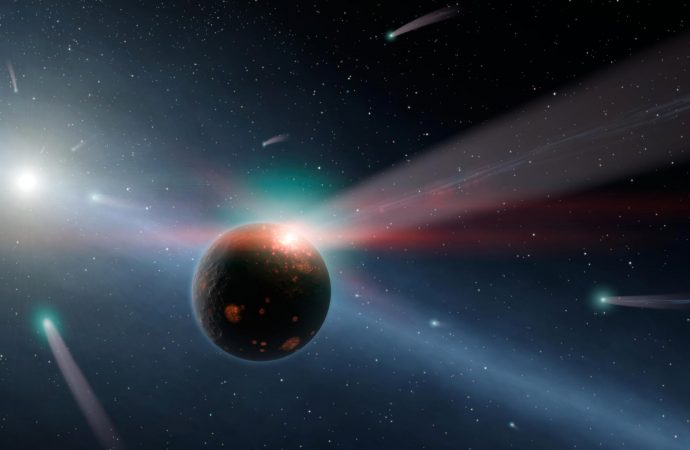An international team of researchers from the United States, Taiwan and France provides new evidence that phosphates — a key element in the building blocks — were generated in outer space and delivered to Earth in its first one billion years by meteorites or comets. The findings are published in the journal Nature Communications.
Phosphates and diphosphoric acid are two major elements that are essential for these building blocks in molecular biology.
They are the main constituents of chromosomes, the carriers of genetic information in which DNA is found.
Together with phospholipids in cell membranes and adenosine triphosphate, which function as energy carriers in cells, they form self-replicating material present in all living organisms.
In an ultra-high vacuum chamber cooled down to minus 450 degrees Fahrenheit (minus 268 degrees Celsius), University of Hawaii at Manoa’s Professor Ralf Kaiser and colleagues replicated interstellar icy grains coated with carbon dioxide, water and phosphine.
When exposed to ionizing radiation in the form of high-energy electrons to simulate the cosmic rays in space, phosphorus oxoacids — phosphoric acid (H3PO4), phosphonic acid (H3PO3), and pyrophosphoric acid (H4P2O7) — were synthesized via non-equilibrium reactions.
“On Earth, phosphine is lethal to living beings. But in the interstellar medium, an exotic phosphine chemistry can promote rare chemical reaction pathways to initiate the formation of biorelevant molecules such as oxoacids of phosphorus, which eventually might spark the molecular evolution of life as we know it,” said team member Andrew Turner, a graduate student at the University of Hawaii at Manoa.
“The phosphorus oxoacids detected in our experiments by combination of sophisticated analytics involving lasers, coupled to mass spectrometers along with gas chromatographs, might have also been formed within the ices of comets such as 67P/Churyumov-Gerasimenko, which contains a phosphorus source believed to derive from phosphine,” Professor Kaiser said.
“These techniques can also be used to detect trace amounts of explosives and drugs.”
“Since comets contain at least partially the remnants of the material of the protoplanetary disk that formed our Solar System, these compounds might be traced back to the interstellar medium wherever sufficient phosphine in interstellar ices is available,” said team member Dr. Cornelia Meinert, a researcher at the University of Nice.
“Upon delivery to Earth by meteorites or comets, these phosphorus oxoacids might have been available for Earth’s prebiotic phosphorus chemistry,” the scientists said.
“Hence an understanding of the facile synthesis of these oxoacids is essential to untangle the origin of water-soluble prebiotic phosphorus compounds and how they might have been incorporated into organisms not only on Earth, but potentially in our Universe as well.”
Source: Sci News

































Leave a Comment
You must be logged in to post a comment.